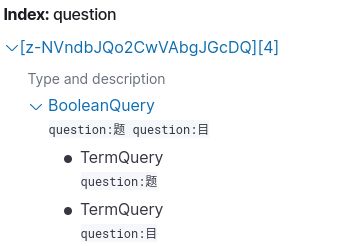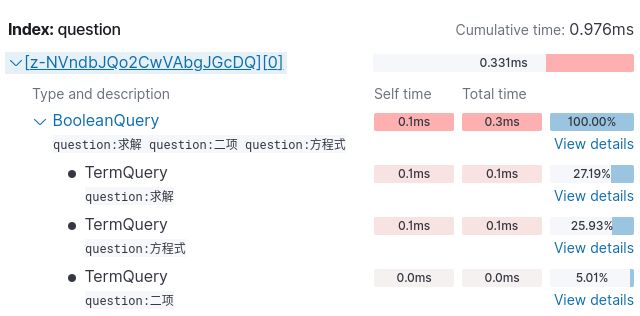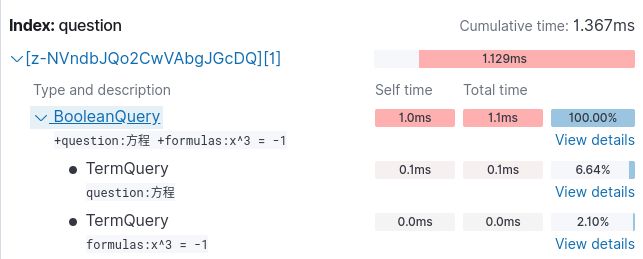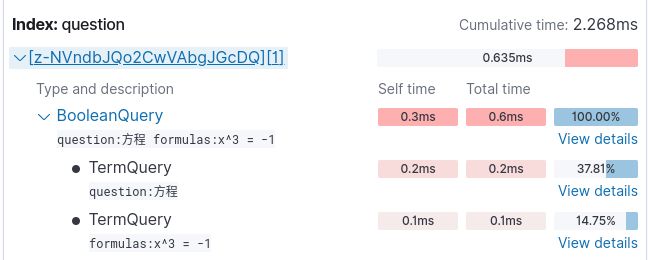1. curl查询的语法
比如,要对 qbank 索引中文档的 queston 属性按“题目含有关于圆周率的数学公式”进行模糊查询:
curl -H "Content-Type: application/json" -XPOST http://localhost:9200/qbank/_search -d '{
"query": {
"match": {
"question": "题目含有关于圆周率的数学公式"
}
}
}'
其效果,类似在浏览器中使用:
http://172.17.0.1:9200/question/_search?q=question=题目含有关于圆周率的数学公式
来查,但前者可以使用完整的查询语法,实现很多复杂的条件组合;后者只能支持其中的 match 查询。
另外,之前曾经用:
curl -XGET http://localhost:9200/qbank/_search -d '{
"query": {
"match": {
"question": "题目含有关于圆周率的数学公式"
}
}
}'
来查,结果报错:
{"error":"Content-Type header [application/x-www-form-urlencoded] is not supported","status":406}
网上很多帖子都说这种查询是可以的,实际操作结果是不行,或者我的 7.6.1 版本不再支持这种写法了。
2. ES支持的几种常用查询模式的例子
本章节以 sql 为标的,列出要达成相似查询效果所需的 dsl 查询语句和 以spring-data-elasticsearch 的 ElasticSearchRestTemplate来查询的Java代码。例子全部在 [email protected] 环境实际测试通过。
假设我的数据模型对应的表名为 t_question,其ElasticResearch 模型如下:
/**
* 题目对象
* @author xxx
* 2020年3月11日 下午9:56:02
*/
@Document(indexName = "question")
public class Question implements Serializable {
@Id
@Field(type= FieldType.Keyword)
private String id;
/**
* 题号
*/
@Field(type=FieldType.Keyword)
private String questionNo;
/**
* 题目类型
*/
@Field(type=FieldType.Text, analyzer = "ik_max_word", searchAnalyzer = "ik_smart")
private String category;
/**
* 题目
*/
@Field(type=FieldType.Text, analyzer = "ik_max_word", searchAnalyzer = "ik_smart")
private String question;
/**
* 从题目中提出取来的公式列表
*/
@Field(type = FieldType.Keyword)
private List formulas;
}
系统自动产生的mapping 映射如下:
{
"mapping": {
"question": {
"properties": {
"category": {
"type": "text",
"analyzer": "ik_max_word",
"search_analyzer": "ik_smart"
},
"formulas": {
"type": "keyword"
},
"id": {
"type": "keyword"
},
"question": {
"type": "text",
"analyzer": "ik_max_word",
"search_analyzer": "ik_smart"
},
"questionNo": {
"type": "keyword"
}
}
}
}
}
2.1 select * from t_question;
显然sql select * from t_question 是要列出所有的题目。
温馨提示:实际操作中千万不要执行类似代码。在一个大数据库中,这个操作可以直接让服务器OOM。
DSL查询语句如下:
{
"query": {
"match_all": {}
}
}
Java查询代码如下:
@Test
void testList() {
QueryBuilder qb = QueryBuilders.matchAllQuery();
SearchQuery searchQuery = new NativeSearchQueryBuilder().withQuery(qb).build();
List results = this.esRestTemplate.queryForList(searchQuery, Question.class);
assertNotNull(results);
assertFalse(results.isEmpty());
}
2.2. 按 keyword 精确查询
在 v7.6.1 中,keyword 就是以前的 no_analysed 的text类型字段。keyword 字段在文档插入时,以文档的对应字段的整个词条内容为一个完整的字符串进行索引,不会先执行分词过程。
在 v7.6.1 版本中,一个text类型的字段,会自动创建 keyword 的映射。也就是它会同时拥有 text 类型的映射 和 keyword 类型的映射。只是如果要引用其 keyword 类型的值,必须使用 字段名.keyword = VALUE 的语法。
这一点,可以通过查看对应索引的mapping数据来验证。
2.2.1. 单个条件值的查询
SQL查询语句如下:
select t.* from t_question t where t.questionNo = '2';
DSL查询语句如下:
{
"query": {
"term": {
"questionNo.keyword": "2"
}
}
}
term 条件,允许指定一个 keyword 类型的值。
Java查询代码如下:
@Test
void testList() {
QueryBuilder qb = QueryBuilders.termQuery("questionNo.keyword", "2");
SearchQuery searchQuery = new NativeSearchQueryBuilder().withQuery(qb).build();
List results = this.esRestTemplate.queryForList(searchQuery, Question.class);
assertNotNull(results);
assertEquals(1, results.size());
}
2.2.2. 单个条件多个值的查询
SQL查询语句如下:
select t.* from t_question t where t.questionNo in ("2", "3", "4")
或者:
select
t.*
from
t_question t
where
t.questionNo = "2"
or
t.questionNo = "3"
or
t.questionNo = "4";
DSL查询语句如下:
{
"query": {
"terms": {
"questionNo.keyword": ["2", "3", "4"]
}
}
}
terms 条件,允许列出多个 keyword 类型的值,只要有一个值匹配,则视为条件匹配。相当于sql 的 in
或者:
{
"query": {
"bool": {
"should": [
{
"term": {
"questionNo.keyword": "2"
}
}, {
"term": {
"questionNo.keyword": "3"
}
}, {
"term": {
"questionNo.keyword": "4"
}
}
]
}
}
}
should 条件,相当于sql的 or。只要有一个条件满足,就视为满足条件。
Java查询代码:
@Test
void testList() {
QueryBuilder qb = QueryBuilders.termsQuery("questionNo.keyword", Arrays.asList("2", "3", "4"));
SearchQuery searchQuery = new NativeSearchQueryBuilder().withQuery(qb).build();
List results = this.esRestTemplate.queryForList(searchQuery, Question.class);
assertNotNull(results);
assertEquals(3, results.size());
}
或
@Test
void testList() {
BoolQueryBuilder qb = QueryBuilders
.boolQuery()
.should(QueryBuilders.termQuery("questionNo.keyword", "2"))
.should(QueryBuilders.termQuery("questionNo.keyword", "3"))
.should(QueryBuilders.termQuery("questionNo.keyword", "4"));
SearchQuery searchQuery = new NativeSearchQueryBuilder().withQuery(qb).build();
List results = this.esRestTemplate.queryForList(searchQuery, Question.class);
assertNotNull(results);
assertEquals(3, results.size());
}
2.3 单个字段的全文本查询
ElasticSearch 的单个字段的全文本查询,其效果大致可以用 SQL 的 like ‘%条件值% 来类比。但你要是真的在 SQL 中执行这样的模糊查询,又碰巧了这个表数据量很大的话,基本上你会被老板炒掉了;因为关系数据库中执行这样的查询,会导致性能极度低下的全表扫描查询;系统轻则卡死,重则宕机。这也是当初 lucene 全文本框架被设计出来的原因。
ElasticSearch 对全文本字段的查询,包含两个过程:
- 保存文档时:ES 先分析对应字段的值,用分词器将字段文本拆分为一系列的短语,然后再根据短语创建从短语到文档的倒排索引。
- 查询文档时:分 match_phrase 查询和 match 查询。
- match_phrase:将查询条件视为一个完整的字符串,并不用分词器进行拆分,直接去匹配索引,搜索结果。
- match:先用分词器将查询条件拆分为多个短语,再用这些短语去匹配索引,结果加入计分,按计分高低排序返回结果。计分越高表明越匹配。
2.3.1. 查询题目包含文本“方程”的题目
SQL脚本如下:
select
t.*
from
t_question t
where
t.question like '%方程%';
DSL脚本为:
{
"query": {
"match_phrase": {
"question": "题目"
}
}
}
Java代码是:
@Test
void testMatchPhraseWithDefaultAnalynizer() {
QueryBuilder qb = QueryBuilders.matchPhraseQuery("question", "题目");
SearchQuery searchQuery = new NativeSearchQueryBuilder().withQuery(qb).build();
List results = this.esRestTemplate.queryForList(searchQuery, Question.class);
assertNotNull(results);
assertEquals(3, results.size());
}
检索时,不分析条件文本,直接作为一个短语去索引中检索。使用kibana分析DSL的结果如下:
可以看到,其检索消耗大约时0.6ms。如果是SQL检索,如果有50万行数据的表,可能会慢的让你怀疑人生。这就是lucene在全文本搜索方面的强大能力体现。
搜索出来的结果如下:
"hits" : {
"total" : {
"value" : 1,
"relation" : "eq"
},
"max_score" : 1.2688576,
"hits" : [
{
"_index" : "question",
"_type" : "question",
"_id" : "7e840a47-a04c-402b-9413-77dd3f1a9cf5",
"_score" : 1.2688576,
"_source" : {
"id" : "7e840a47-a04c-402b-9413-77dd3f1a9cf5",
"questionNo" : "13",
"category" : "测试题目",
"question" : """这道题目是为了测试有两个公式的题目\(x^4 - 16 = 0\)和\(x^3 = -1\) 是否能正常检索""",
"formulas" : [
"x^4 - 16 = 0",
"x^3 = -1"
]
}
}
]
}
2.3.2. 按匹配度查询和文本“求解二项方程式”类似的题目
这个条件,SQL没有办法做到,这就是lucene最擅长处理的场景之一。如果实在要SQL进行模拟,比如搜索和那么需要按如下步骤进行再额外需要大约500行纯粹的Java代码,而且很可能效果还不好:
- 先将“求解二项方程式”拆分为“求”、“解”、“二项”、“方程式”
- 执行如下SQL:
select t.* from t_question t where t.question like '%求%'
union
select t.* from t_question t where t.question like '%解%'
union
select t.* from t_question t where t.question like '%二项%'
union
select t.* from t_question t where t.question like '%方程式%'
- 想办法处理2的查询结果,从中挑选比较匹配的。
而 lucene 处理起来,非常的得心应手:
DSL脚本如下:
{
"query": {
"match": {
"question": "求解二项方程式"
}
}
}
Java代码如下:
@Test
void testMatchPhraseWithDefaultAnalynizer() {
QueryBuilder qb = QueryBuilders.matchQuery("question", "求解二项方程式");
SearchQuery searchQuery = new NativeSearchQueryBuilder().withQuery(qb).build();
List results = this.esRestTemplate.queryForList(searchQuery, Question.class);
assertNotNull(results);
assertEquals(3, results.size());
}
需要注意的是:这个DSL的效果,跟采用的分词器有关。因为 question 这个列,是 text 类型的,在添加document时,会先用分词器分析得到短语列表,再建立短语和document的索引。搜索时,match 条件,会将搜索条件先用分词器处理,再去匹配。
分词器的使用场景,分为添加文档时维护索引的分析器,和检索结果时分析查询文本时使用的分析器。两个分析器使用场景不同,需要分别设置;如果不设置,则会使用默认分析器,就是将每个汉字拆分为一个独立的短语。关于如何指定两种分析器可以看这里。
-
使用默认分词器,那么会将“求解二项方程式”中的每个字都处理为一个短语,也就是“求”、“解”、“二”、“项”、“方”、“程”和“式”一共7个短语。因此,搜索的结果,会是分别用上述7个短语在索引中检索后再综合评分的结果。使用kibana对上面的DSL进行分析的结果如下图:
-
使用中文分词器,那么会认得“求解二项方程式”是由如下三个有意义的短语构成:“求解”、“二项”、“方程式”,而不会拆成没有含义的7个汉字。
DSL分析如下:
得到的检索结果如下:
"hits" : {
"total" : {
"value" : 1,
"relation" : "eq"
},
"max_score" : 1.156497,
"hits" : [
{
"_index" : "question",
"_type" : "question",
"_id" : "ba43b4df-2494-43a6-a85c-5413eb65d1b1",
"_score" : 1.156497,
"_source" : {
"id" : "ba43b4df-2494-43a6-a85c-5413eb65d1b1",
"questionNo" : "10",
"category" : "测试题目",
"question" : """求解方程式:\(\left\{\begin{array}{**lr**}x=\dfrac{3\pi}{2}(1+2t)\cos(\dfrac{3\pi}{2}(1+2t))&\\y=s&\\z=\dfrac{3\pi}{2}(1+2t)\sin(\dfrac{3\pi}{2}(1+2t))\end{array}\right.\)""",
"formulas" : [
"\\left\\{\\begin{array}{**lr**}x=\\dfrac{3\\pi}{2}(1+2t)\\cos(\\dfrac{3\\pi}{2}(1+2t))&\\\\y=s&\\\\z=\\dfrac{3\\pi}{2}(1+2t)\\sin(\\dfrac{3\\pi}{2}(1+2t))\\end{array}\\right."
]
}
}
]
}
2.3. 多个条件的组合查询
在SQL中,可以通过 and or 的组合,提供多个条件的查询。DSL中也可以,但它是通过一个叫做 bool 的操作进行的。
2.3.1 查询含有公式x^3 = -1且含有文本方程的题目
SQL脚本如下:
select
t.*
from t_question t
where
t.formulas = 'x^3 = -1'
and
t.question like '%方程%'
实际上SQL是没有办法通过一个表来实现要求的查询的。因为同一个题目的公式,可能有两个:\(x^3 = -1\) 和 \(x^4 = 1\)。而表的一个字段,职能放一个公式。如果要放两个公式,要么将多个公式通过字符串存储起来,要么另外创建一个表存放公式,然后通过外键关联。但为了简化问题,我们先假设题目只有一个公式。
DSL脚本如下:
{
"query": {
"bool": {
"must": [{
"match": {
"question": "方程"
}
}, {
"term": {
"formulas": "x^3 = -1"
}
}]
}
}
}
Java代码如下:
@Test
void testMustWith2Conditons() {
BoolQueryBuilder bqb = QueryBuilders.boolQuery()
.must(QueryBuilders.matchQuery("question", "方程"))
.must(QueryBuilders.termQuery("formulas", "x^3 = -1"));
SearchQuery searchQuery = new NativeSearchQueryBuilder().withQuery(bqb).build();
List results = this.esRestTemplate.queryForList(searchQuery, Question.class);
assertNotNull(results);
assertEquals(1, results.size());
}
这个DSL的分析结果如下:
可以看到,由于在索引映射中指定采用了 ik_max_word 作为查询字符串的分析器,它分析出“方程”整体是一个词条,没有进一步拆分。
查询结果如下:
"hits" : {
"total" : {
"value" : 1,
"relation" : "eq"
},
"max_score" : 1.1848769,
"hits" : [
{
"_index" : "question",
"_type" : "question",
"_id" : "79edc184-c5a5-4cd3-8c53-a0cfce258c53",
"_score" : 1.1848769,
"_source" : {
"id" : "79edc184-c5a5-4cd3-8c53-a0cfce258c53",
"questionNo" : "3",
"category" : "测试题目",
"question" : """方程\(x^3 = -1\) 的根是""",
"formulas" : [
"x^3 = -1"
]
}
}
]
}
2.3.2 查询含有公式x^3 = -1或含有文本方程的题目
SQL脚本如下:
select
t.*
from t_question t
where
t.formulas = 'x^3 = -1'
or
t.question like '%方程%'
DSL脚本如下:
{
"query": {
"bool": {
"should": [{
"match": {
"question": "方程"
}
}, {
"term": {
"formulas": "x^3 = -1"
}
}]
}
}
}
Java代码如下:
@Test
void testShouldWith2Conditons() {
BoolQueryBuilder bqb = QueryBuilders.boolQuery()
.should(QueryBuilders.matchQuery("question", "方程"))
.should(QueryBuilders.termQuery("formulas", "x^3 = -1"));
SearchQuery searchQuery = new NativeSearchQueryBuilder().withQuery(bqb).build();
List results = this.esRestTemplate.queryForList(searchQuery, Question.class);
assertNotNull(results);
assertEquals(1, results.size());
}
这个DSL的分析结果如下:
对比一下 2.3.1. 的and关系,会发现 and 关系上有个 + 号,or 关系上是没有这个 + 号。
查询结果如下:
"hits" : {
"total" : {
"value" : 13,
"relation" : "eq"
},
"max_score" : 1.1848769,
"hits" : [
{
"_index" : "question",
"_type" : "question",
"_id" : "79edc184-c5a5-4cd3-8c53-a0cfce258c53",
"_score" : 1.1848769,
"_source" : {
"id" : "79edc184-c5a5-4cd3-8c53-a0cfce258c53",
"questionNo" : "3",
"category" : "测试题目",
"question" : """方程\(x^3 = -1\) 的根是""",
"formulas" : [
"x^3 = -1"
]
}
},
{
"_index" : "question",
"_type" : "question",
"_id" : "7e840a47-a04c-402b-9413-77dd3f1a9cf5",
"_score" : 0.7549127,
"_source" : {
"id" : "7e840a47-a04c-402b-9413-77dd3f1a9cf5",
"questionNo" : "13",
"category" : "测试题目",
"question" : """这道题目是为了测试有两个公式的题目\(x^4 - 16 = 0\)和\(x^3 = -1\) 是否能正常检索""",
"formulas" : [
"x^4 - 16 = 0",
"x^3 = -1"
]
}
},
......
}
这个 or 关系的查询一出来,结果就多了,一共13条。这里只贴出前2条。
2.3.2 查询同时含有公式x^3 = -1 和x^4 - 16 = 0,或含有文本实数的题目
这个要求要用SQL写就复杂了。
- 如果分为两个表,一个放题目,一个放公式,通过外键关联,那么其脚本如下:
select
q.*
from
t_question q
where
q.question like '%实数%'
or (
exists(
select 1
from
t_formula f
where
q.id = f.ques_id
and
f.formula = 'x^3 = -1'
)
and exists(
select 1
from
t_formula f
where
q.id = f.ques_id
and
f.formula = 'x^4 - 16 = 0'
)
)
- 如果是在 t_question 表中,用一个文本字段来存储所有公式,那么SQL语句如下:
select
t.*
from
t_question t
where
t.question like '%实数%'
or (
t.formulas like 'x^3 = -1'
and
t.formulas like 'x^4 - 16 = 0'
)
无论是上面那个语句,其性能都极其感人。
而对应效果的DSL脚本如下:
{
"query": {
"bool": {
"should": [
{
"match": {
"question": "实数"
}
},
{
"bool": {
"must": [
{
"term": {
"formulas": "x^3 = -1"
}
},
{
"term": {
"formulas": "x^4 - 16 = 0"
}
}
]
}
}
]
}
}
}
Java代码如下:
@Test
void testMixMustAndShould() {
BoolQueryBuilder sqb = QueryBuilders.boolQuery()
.must(QueryBuilders.termQuery("formulas", "x^4 - 16 = 0"))
.must(QueryBuilders.termQuery("formulas", "x^3 = -1"));
BoolQueryBuilder bqb = QueryBuilders.boolQuery()
.should(QueryBuilders.matchQuery("question", "实数"))
.should(sqb);
SearchQuery searchQuery = new NativeSearchQueryBuilder().withQuery(bqb).build();
List results = this.esRestTemplate.queryForList(searchQuery, Question.class);
assertNotNull(results);
assertEquals(1, results.size());
}
这个DSL的分析结果如下:
查询结果如下:
"hits" : {
"total" : {
"value" : 4,
"relation" : "eq"
},
"max_score" : 2.427258,
"hits" : [
{
"_index" : "question",
"_type" : "question",
"_id" : "16f00905-d2a9-4576-b4f9-0dbd1d63516d",
"_score" : 2.427258,
"_source" : {
"id" : "16f00905-d2a9-4576-b4f9-0dbd1d63516d",
"questionNo" : "13",
"category" : "测试题目",
"question" : """这道题目是为了测试有两个公式的题目\(x^4 - 16 = 0\)和\(x^3 = -1\) 是否能正常检索""",
"formulas" : [
"x^4 - 16 = 0",
"x^3 = -1"
]
}
},
{
"_index" : "question",
"_type" : "question",
"_id" : "65317f92-fc9a-4219-ac35-3be55126fa44",
"_score" : 1.3862942,
"_source" : {
"id" : "65317f92-fc9a-4219-ac35-3be55126fa44",
"questionNo" : "6",
"category" : "测试题目",
"question" : """已知二项方程 \(3x^4 + m = 0 \)没有实数根,则m的取值范围是""",
"formulas" : [
"3x^4 + m = 0 "
]
}
},
{
"_index" : "question",
"_type" : "question",
"_id" : "d5112bcc-3436-4114-a1c2-9fb20cebad75",
"_score" : 0.7098105,
"_source" : {
"id" : "d5112bcc-3436-4114-a1c2-9fb20cebad75",
"questionNo" : "8",
"category" : "测试题目",
"question" : """对于二项方程 \(ax^n + b = 0(a \neq 0, b \neq 0)\),当n为偶数时,已知方程有两个实数根。那么 ab""",
"formulas" : [
"ax^n + b = 0(a \\neq 0, b \\neq 0)"
]
}
},
{
"_index" : "question",
"_type" : "question",
"_id" : "72a926a4-bbcb-46e2-92fe-6c2c76c191d2",
"_score" : 0.6125949,
"_source" : {
"id" : "72a926a4-bbcb-46e2-92fe-6c2c76c191d2",
"questionNo" : "9",
"category" : "测试题目",
"question" : """已知方程组\(\left\{\begin{array}{**lr**}y^2=2x&\\y=kx+1&\end{array}\right.\)有两个不相等的实数解,求k的取值范围""",
"formulas" : [
"\\left\\{\\begin{array}{**lr**}y^2=2x&\\\\y=kx+1&\\end{array}\\right."
]
}
}
]
}
`





